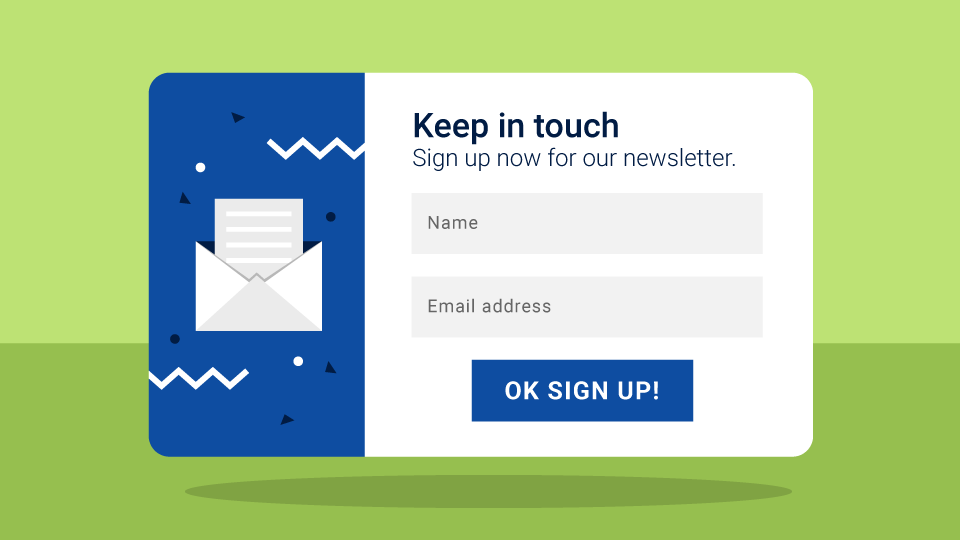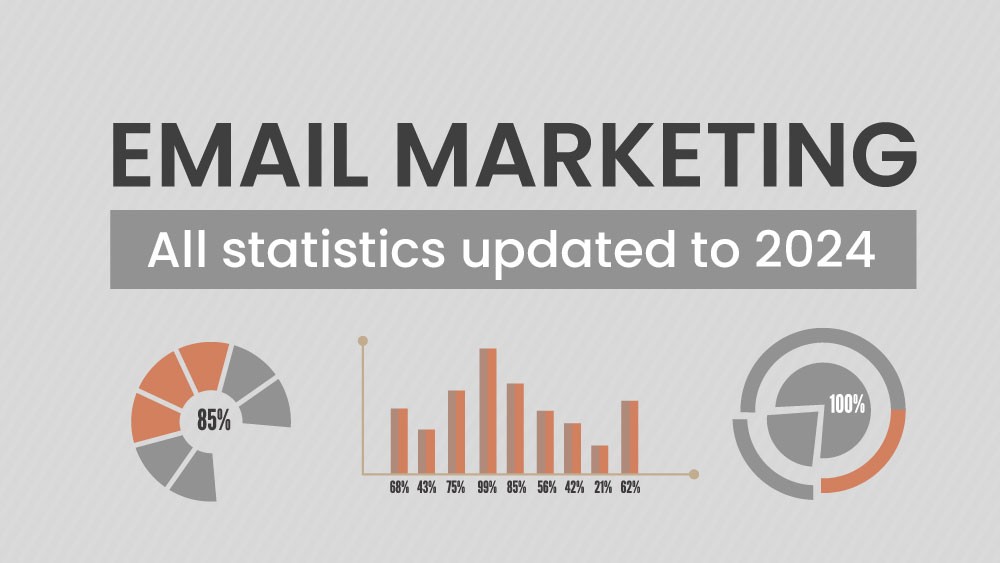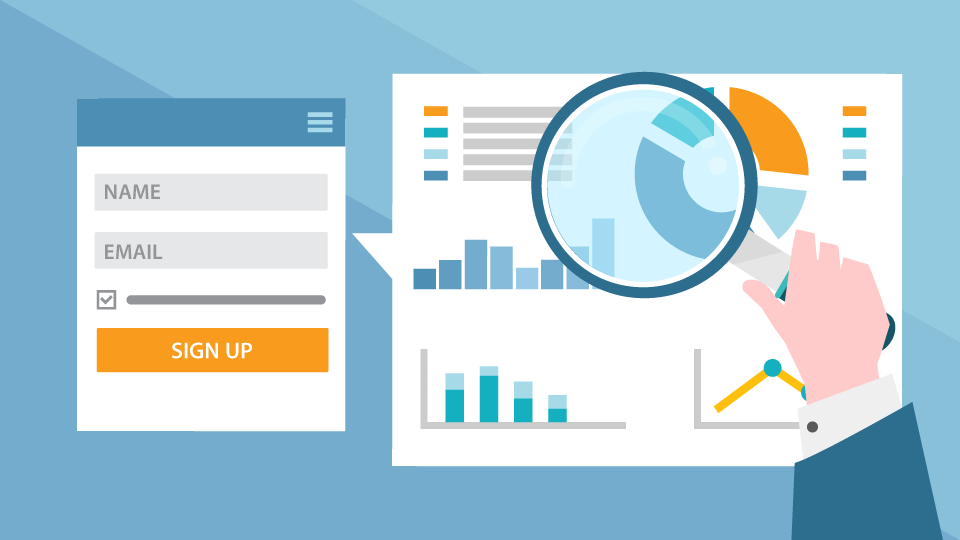The high rate of return and its ease of use make email one of the most effective communication channels for acquiring and retaining customers. But every email marketing strategy relies on a single component: the sign-up form. Only with an effective sign-up form can you create a database of contacts who are truly interested in your brand and your sector, and are more likely to convert into loyal and informed customers. Let’s see what a sign-up form is and how to structure it to increase your flow of newsletter subscribers.
What Is a Sign-Up Form?
The sign-up form is a form on a web page that the visitor must complete to leave their email address and give you their authorization to receive your newsletters and other marketing material.
The registration form is the only way you can collect valid contacts for your mailing list. It has to be perfect. Buying contact lists is not a strategy. It’s ineffective, could undermine your online reputation, and might cause you some serious deliverability problems.
How to Win More Subscribers With a Good Subscription Form
The registration form is your cover letter. If it is not engaging and does not offer real benefits, users are unlikely to leave their contact data. If you think your form is not getting you the results you were hoping for, keep reading our tips to learn how to improve it.
8 Steps to Increase Newsletter Subscriptions
-
Highlight the Subscription Benefits
Users who reach your landing page and your form should have no doubts about why they should sign up. Use the headline to make your offer to your subscribers clear, and explain why they need what you’re offering.
In the description below the headline, include some additional information. For example, if you sell fitness and online courses, and you want users to leave their email address in exchange for a trial lesson, show subscribers what your lessons will do for them. You could also explain what your subscribers will receive in their newsletter and how often. You’ll be able to screen your subscribers and collect the contact addresses of people genuinely interested in your brand and your service.
Remember, numbers are important, of course, but it’s interested contacts that fill a mailing list with potential customers ready for conversion.
-
Use Contrasting Colors
The effectiveness of a registration form depends not only on the text but also on the design of the form. Try using templates with contrasting colors so that users immediately see your form and understand how to complete it. Losing a conversion because your form and its components weren’t visible enough would be a real shame.
-
Limit the Number of Fields Users Must Complete
It can be tempting to create a form with as many fields as possible. After all, you want to capture as much information about your subscribers as you can. But this is a bad idea.
Having access to a lot of data will help you to customize your email marketing campaigns. But a long form will also discourage visitors. They’ll find themselves in front of a form that takes time to complete and that might ask for information they’re not yet ready to tell you.
We recommend that you choose a form with just a few fields, such as name, surname, and email address. Pick up the rest of the data later, exploiting the email channel to which you have just gained access.
-
Test Everything
To expand your pool of subscribers, you need to test as much as possible. You need to find the best position for your sign-up form, the most outstanding colors, and the most effective CTA. To understand which options work the best, you need to test and monitor your data. If your page welcomes many visitors but does not deliver conversions, it may be the registration form that is the problem.
That’s why you have to track the results with professional tools. Emailchef has a special section that lets you see data about your form performances: the number of views, conversion rate, email addresses obtained (complete with the place the registration was made and the referral page from which the user reached your form). All this information can be useful to understand what is wrong with your form and help you to improve it.
-
Use a Form Builder
Create professional sign-up forms using the right tools. Choose an email marketing platform such as Emailchef and take advantage of the very easy Drag & Drop Editor to create attractive forms. With a professional solution you can customize your forms, changing the colors, adding a footer or other information fields, and configure your subscription preferences such as by choosing between single and double opt-in modes. It’s the easiest way to start sending your newsletters.
-
Give Your Subscribers Agency
To improve both the opening rate and the engagement rate of your newsletters, you can use a little trick: let your subscribers choose their preferences.
Giving users the ability to choose a topic for which they want to be contacted, and the frequency with which they want to receive your messages, can bring real advantages to your digital marketing strategy. The more users feel they can customize their experience, the more likely they will be to leave you their email address and join your mailing list. Inserting fields in the registration form indicating the topic of interest and desired contact frequency costs nothing, but it can really make a difference when it comes to collecting contacts and improving the final conversion rate!
-
Use a Clear CTA and a Large, Unmissable Button
The call to action should be short and concise. It should invite users to join your contact list to receive your content. The simplest of CTAs (like “Sign Up”) can be effective… but it can also be boring. This is why it is important to work the texts of the CTAs and to give impulse to your creativity.
Remember, don’t use too many words, and always be clear. Use personal and friendly language (wherever possible) and never lose sight of the objectives of your subscribers.
To prevent your form becoming lost on the page and going unnoticed, use a visible CTA button and highlight it. Make sure that there are no more than one or two calls to action on the same page. -
Respect the Font Size Hierarchy
To create a subscription form that works and attracts subscribers, you need to follow a typographic hierarchy. The choice of fonts and their sizes should enable users to see at a glance both the information they are looking for and what you want them to find, such as the subscription CTA. If the choice of fonts is well planned, the registration form will be easier to read and complete. It will help users better understand the value of the registration and what you are offering them.
The rules on typographic hierarchy require you to use the largest characters for the headline and increasingly smaller characters for the CTA, subheadline, and description. You can still play with styles, and use italics or bold or even all capital letters if your website and brand allow it.








